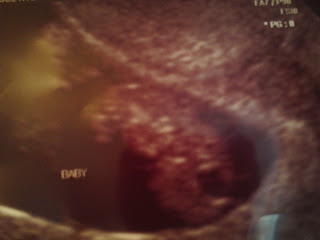What is that fancy scientific name for being born with your intestines on the outside of the body?
It is called Gastroschisis (Gas-troh-skee-sis). It only occurs in 1 of 5,000 live births. Surprisingly, it is not a birth defect of the INTESTINES. The true culprit of the infamous diagnosis is the abdominal wall (aka the "abs"). Very early in pregnancy, the abdominal muscles of the fetus do not form correctly, leaving a hole usually to the right of the umbilical cord (where the intestines are allowed to float out).
Imagine how small a fetus is during those first two months of pregnancy (when gastroschisis first occurs). Imagine how small the fetus's little intestines are. I imagine that those tiny intestines just float on out of that hole (of the abdominal muscles) with ease. But then, when the pregnancy continues and the fetus begins growing, the intestines mature and grow, too. The part of the intestines that floated out with ease is now growing on the outside of the body and constantly being irritated by the amniotic fluid.
Did you know that she was to be born with her intestines on the outside of her body? Or was it a surprise at her birth?
We get this questions all the time, too. Well, we had one initial ultrasound for Celia at about eight weeks gestation, when she was only about 4cm long. Looking back at that obscure ultrasound picture, when she looked like a peanut, I think I do see her intestines floating about. However, the Obstetrician did not detect her gastroschisis during that eight week ultrasound (as they usually do not detect it that early).

I was finally 19 weeks pregnant. Alex and I had been waiting, very impatiently I must admit, to get to this point. The point in pregnancy when you find out if that little heart beat you have been hearing is a boy or a girl! It is also the point in pregnancy when you get to see that sweet baby again, but much more closely this time. It is usually the last ultrasound you have during your pregnancy, too. (Though some mothers, I know, have another ultrasound before the birth).
"It's a girl!"
Happiest. Moment. Ever.
Not because she was a girl and we didn't want a boy (which is untrue); but because this was the moment when we really got to see our sweet child. It just felt so much more real, I guess. We saw her precious feet, her healthy spine, her cute little thighs, her beautiful profile, and we saw her wiggling all around like a "normal", healthy baby.
The Staff. Saw. Intestines.
A month after that appointment, we had an ultrasound every week. Then, twice a week.
 |
| It looks creepy because it is 3D. That is her precious face with her intestines over it! 27 weeks gestation. |
 |
| Her intestines floating in the top left corner. 33 weeks gestation. |
Why was Celia's condition so life-threatening?
Let me start by complicating this question/answer by saying that Celia is perfectly FINE. We do not anticipate any complications in her future either. Usually, babies with gastroschisis have a GREAT prognosis (a great chance at recovering and leading a normal life). Celia however, developed an "atresia" (a gap in her intestinal plumbing) as her intestines did not form fully or correctly. She was also born with her stomach out in addition to her intestines.
Here is a picture of ADULT sized intestines. Newborns have half this amount. Celia was born with an atretic jejunum (the first part of the small intestines-they are a purplish color in the picture...right after the stomach). Atretic means gap. It means that they DO NOT WORK. That they WILL NOT WORK. EVER.
-This next part is somewhat difficult to understand, so follow closely-
Her surgical report specifically said that she had 4-5 inches of clear atretic jejunum. After that 4-5 inches was 4-5 inches of dialated (enlarged) jejunum. The rest of the small intestine was "quite underdeveloped" and did not appear to have any "appreciable lumen". (A lumen is the opening in the intestines that food passes through). The abnormal bowel included both the ileocecal valve and the ascending colon. Without small intestines, it is not possible to live.
 |
| The surgeon described her intestines as plumbing. I drew a picture of pipes that are all connected to each other normally, just as intestines usually are. |
 |
| This is a picture I drew of Celia's plumbing. The dashed lines are the gaps that were in her plumbing, the atresias/malformations/underdevolopments. See how that just doesn't work? |
The very last two sentences of her birth report state, "The surgeon indicates grave concern due to very large segment of bowel that appears severely atretic. It is unclear at this time if the baby will have enough functional bowel to survive."
What does her belly look like? Does she have a belly button?
 |
| Before |
 |
| Now |





Wow! Great job Julya of explaining her condition! She is a living miracle!
ReplyDelete